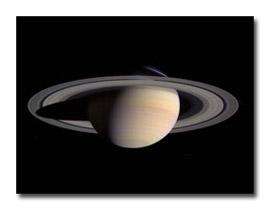Through Saturn's atmosphere

Saturn is famous for its rings. Nevertheless, it does have other, characteristic if not unique, features – its atmosphere, for example. The prime aim of the Planetary Science Group at the University of the Basque Country (EHU-UPV) in Spain is, in fact, to study the atmospheres of the planets: their cloud formations and fogs, how these are distributed vertically in the atmosphere, their movement and their meteorology in general.
To study Saturn's atmosphere, images from the Hubble space telescope were used. There were numerous photographs – more than 200 were taken over the ten-year period from 1994 to 2004. These are pictures that enabled us to find out what the planet is like and what it looks like, observed in different wavelengths. This is the observational part of the study.
But, a numerical simulation can also be undertaken. This is based on the use of numerical codes, which reproduce the manner in which photons enter the atmosphere, and how they are emitted in different directions until some of them are absorbed and others emitted once again into space, i.e. reflected by the atmosphere.
These numerical codes have been developed over the past few years by a team from the EHU-UPV who, on analysing this light reflected by the atmosphere, were able to infer what particles are behind this reflection, i.e. by observing the reflected light, they could determine the number of cloud layers, their depth, the optical properties thereof, and so on. In this way, Saturn's clouds and their evolution were studied over ten years, a relatively long time for a study of this nature.
Wind variation
Once the structural characteristics of the atmosphere were determined, other members of the team were able to evaluate the altitude at which these winds were located on the giant planet. This is of great importance in understanding the meteorology of the planet, given that it provides a three-dimensional image of its atmosphere.
In 2003, the Planetary Science Group, with images from the Hubble space telescope, observed an intense variation of the winds in Saturn's atmosphere at its equator - in comparison to the previous measurements by the Voyager space probe. This was something that nobody really expected.
The winds at the equator of Saturn, measured by the Voyager space probe at the beginning of the 80s, blew with an enormous force - about 1700 km/h. Nevertheless, in 2003, a drop of 40% in this value was observed, as if a brake had been applied to the winds. Subsequently, when the Cassini probe arrived in 2004, it was observed that, at certain wavelengths, there were slower winds and, at others, more rapid winds. Thus, the hypothesis was put forward that the winds slackened according to altitude – the winds blowing at higher altitudes were less intense than those at lower altitudes. This, in principle, would have been expected, given that atmospheric winds generally vary with height. The EHU-UPV team quantified this hypothesis in such a way as to make it a valid one, based on measurements of the variation of the wind as a function of altitude.
Nevertheless, compared with the winds measured in the Voyager period, it was shown, effectively, that there had been an important variation. The fact is that, in 1990, there was an enormous storm at the equator of Saturn. On Saturn there is a phenomenon that repeats itself every 30 years approximately – a huge storm that disturbs an enormous region of the planet, a storm several times bigger than our own planet. The Planetary Science Group at EHU-UPV are currently trying, amongst other endeavours, to analyse how this type of phenomena might affect an atmosphere like that on planet Saturn.
Source: Elhuyar Fundazioa





















